21.5-inch iMac (Late 2013) Review: Iris Pro Driving an Accurate Display
by Anand Lal Shimpi on October 7, 2013 3:28 AM ESTGPU Performance: Iris Pro in the Wild
The new iMac is pretty good, but what drew me to the system was it’s among the first implementations of Intel’s Iris Pro 5200 graphics in a shipping system. There are some pretty big differences between what ships in the entry-level iMac and what we tested earlier this year however.
We benchmarked a Core i7-4950HQ, a 2.4GHz 47W quad-core part with a 3.6GHz max turbo and 6MB of L3 cache (in addition to the 128MB eDRAM L4). The new entry-level 21.5-inch iMac is offered with no CPU options in its $1299 configuration: a Core i5-4570R. This is a 65W part clocked at 2.7GHz but with a 3GHz max turbo and only 4MB of L3 cache (still 128MB of eDRAM). The 4570R also features a lower max GPU turbo clock of 1.15GHz vs. 1.30GHz for the 4950HQ. In other words, you should expect lower performance across the board from the iMac compared to what we reviewed over the summer. At launch Apple provided a fairly old version of Iris Pro drivers for Boot Camp, I updated to the latest available driver revision before running any of these tests under Windows.
Iris Pro 5200’s performance is still amazingly potent for what it is. With Broadwell I’m expecting to see another healthy increase in performance, and hopefully we’ll see Intel continue down this path with future generations as well. I do have concerns about the area efficiency of Intel’s Gen7 graphics. I’m not one to normally care about performance per mm^2, but in Intel’s case it’s a concern given how stingy the company tends to be with die area.
The comparison of note is the GT 750M, as that's likely closest in performance to the GT 640M that shipped in last year's entry-level iMac. With a few exceptions, the Iris Pro 5200 in the new iMac appears to be performance competitive with the 750M. Where it falls short however, it does by a fairly large margin. We noticed this back in our Iris Pro review, but Intel needs some serious driver optimization if it's going to compete with NVIDIA's performance even in the mainstream mobile segment. Low resolution performance in Metro is great, but crank up the resolution/detail settings and the 750M pulls far ahead of Iris Pro. The same is true for Sleeping Dogs, but the penalty here appears to come with AA enabled at our higher quality settings. There's a hefty advantage across the board in Bioshock Infinite as well. If you look at Tomb Raider or Sleeping Dogs (without AA) however, Iris Pro is hot on the heels of the 750M. I suspect the 750M configuration in the new iMacs is likely even faster as it uses GDDR5 memory instead of DDR3.
It's clear to me that the Haswell SKU Apple chose for the entry-level iMac is, understandably, optimized for cost and not max performance. I would've liked to have seen an option with a high-end R-series SKU, although I understand I'm in the minority there.
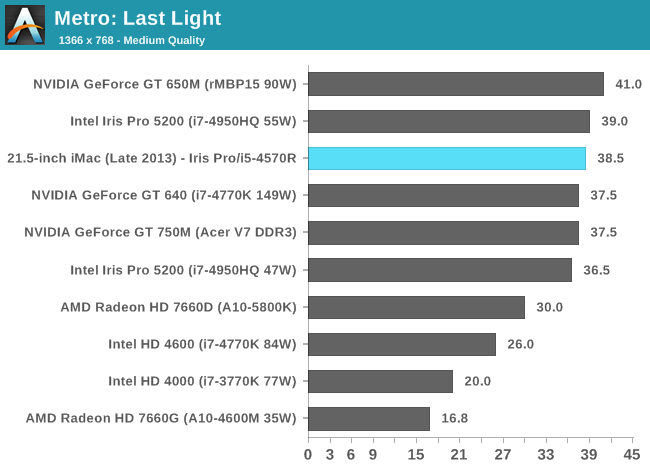
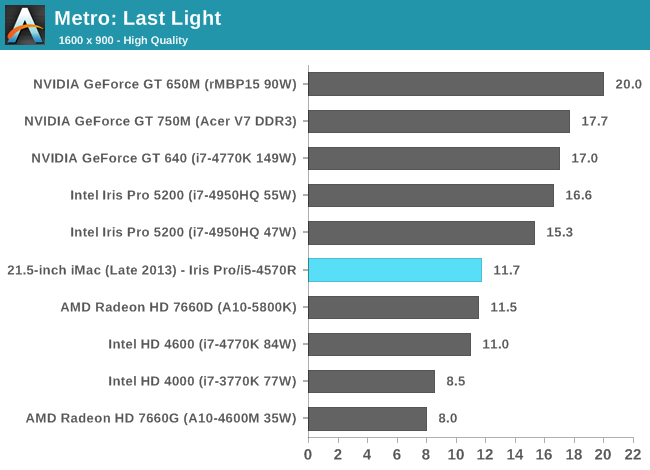
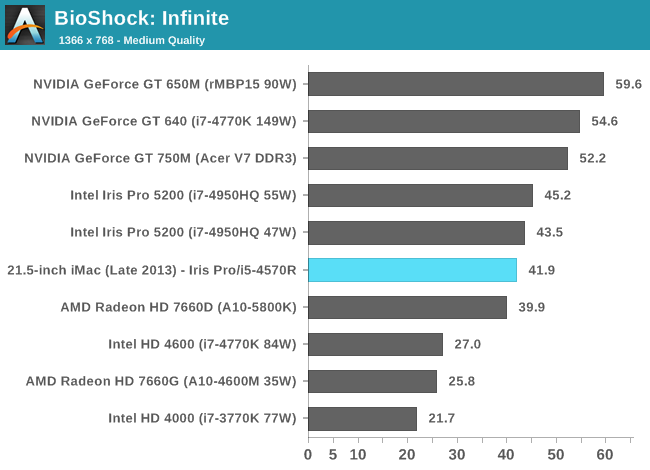
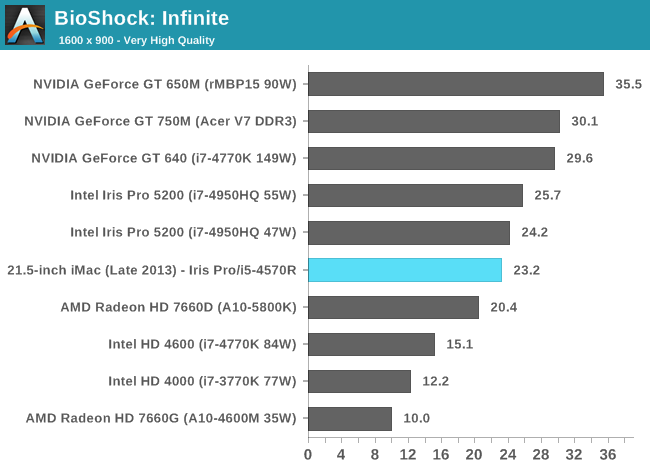
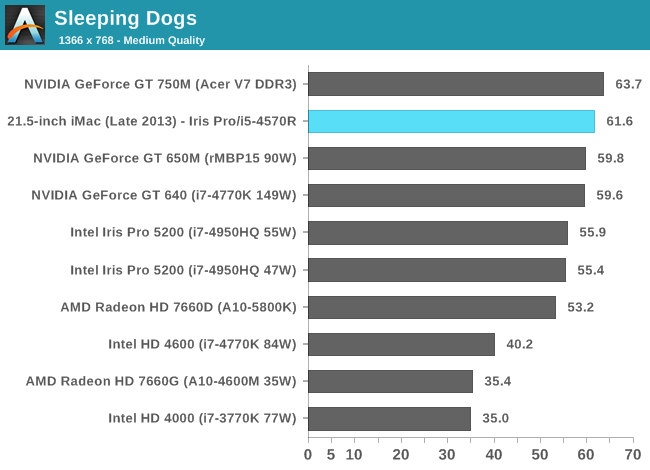
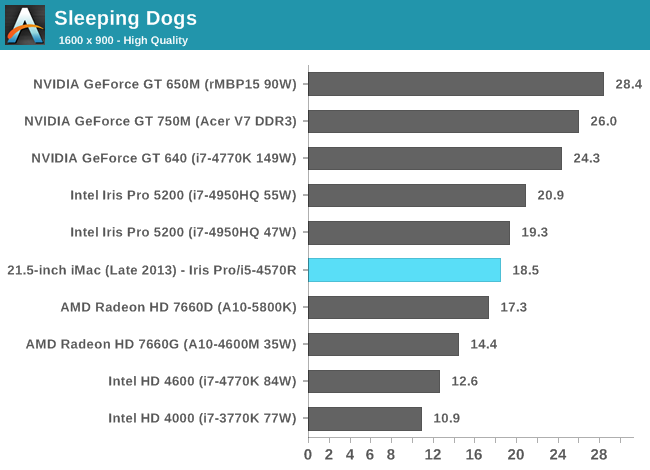

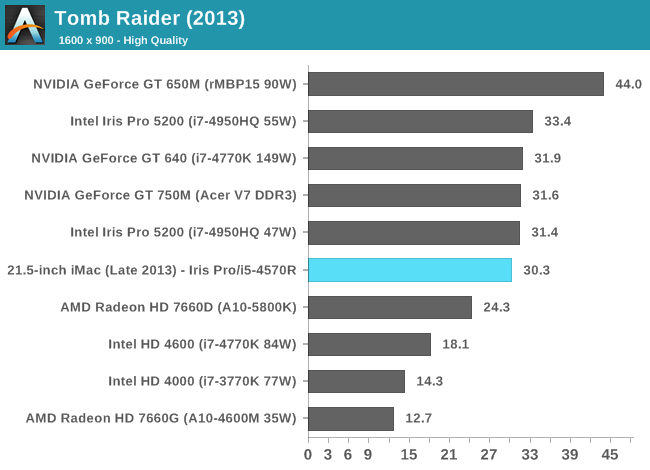
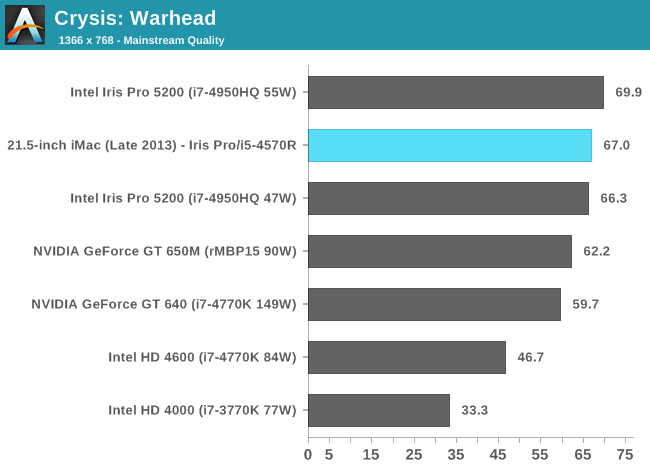
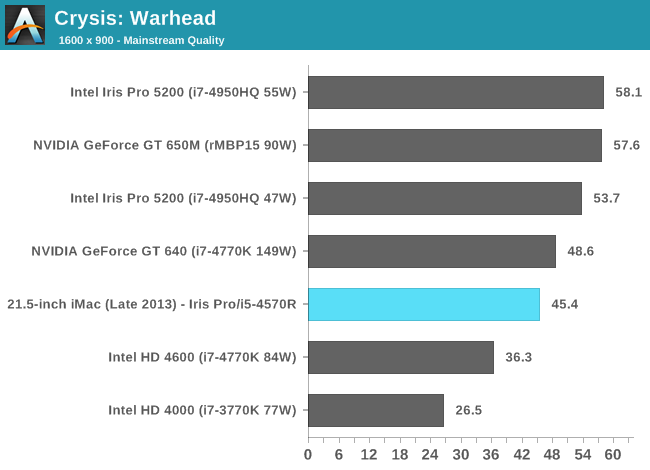
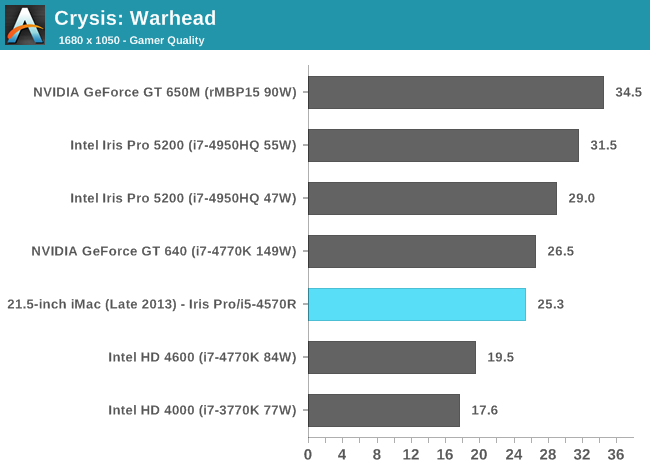
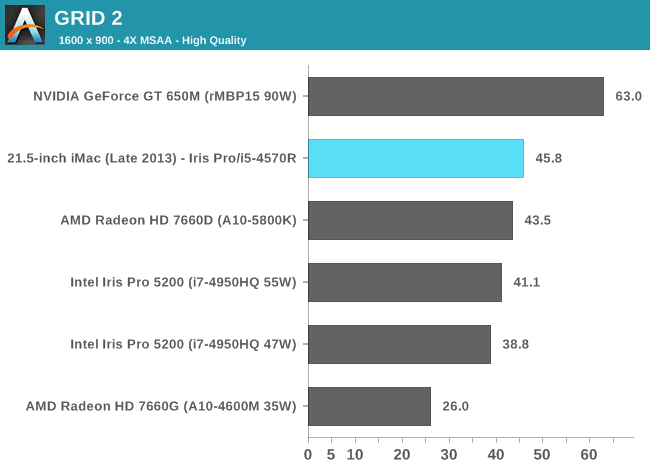
These charts put the Iris Pro’s performance in perspective compared to other dGPUs of note as well as the 15-inch rMBP, but what does that mean for actual playability? I plotted frame rate over time while playing through Borderlands 2 under OS X at 1080p with all quality settings (aside from AA/AF) at their highest. The overall experience running at the iMac’s native resolution was very good:
With the exception of one dip into single digit frame rates (unclear if that was due to some background HDD activity or not), I could play consistently above 30 fps.
Using BioShock Infinite I actually had the ability to run some OS X vs. Windows 8 gaming performance numbers:
| OS X 10.8.5 vs. Windows Gaming Performance - Bioshock Infinite | ||||
| 1366 x 768 Normal Quality | 1600 x 900 High Quality | |||
| OS X 10.8.5 | 29.5 fps | 23.8 fps | ||
| Windows 8 | 41.9 fps | 23.2 fps | ||
Unsurprisingly, when we’re not completely GPU bound there’s actually a pretty large performance difference between OS X and Windows gaming performance. I’ve heard some developers complain about this in the past, partly blaming it on a lack of lower level API access as OS X doesn’t support DirectX and must use OpenGL instead. In our mostly GPU bound test however, performance is identical between OS X and Windows - at least in BioShock Infinite.


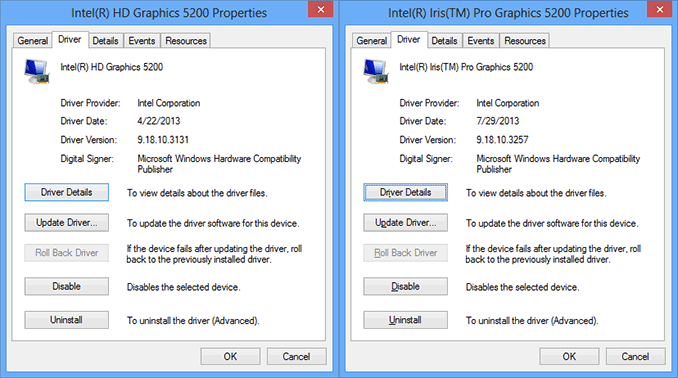
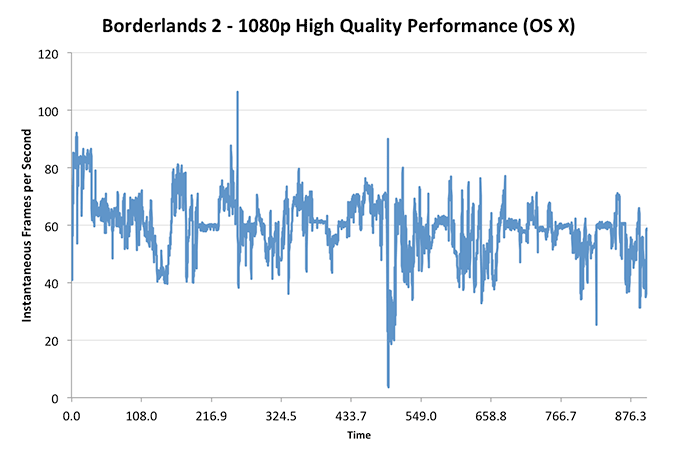








127 Comments
View All Comments
foolio5 - Monday, October 14, 2013 - link
Sammy 840 EVO 128 GB SSD is $99 bucks and up there in the speed/longevity department.akdj - Tuesday, October 15, 2013 - link
Sammy 840 will read about half the speed of the new PCIe SSD in the 2013 iMac. It'll be at least twice as quick. These aren't 2.5" SATA3 drives. They're PCIe. Big difference. Small price to pay for the upgrade. You'll never know you don't have a 1.15 TB SSD in there for most consumer workflows. They. Flat. Fly. It's a bargain. That said, I'm with you on the RAM. $100 for 16 seems fair and nicely set for three-five years. While still being able to sell it for 50% after a half decade :-)djscrew - Monday, October 7, 2013 - link
putting a hard drive in, even at a base level, should be considered a crime to computing in this day and age... a 256 gb ssd should be stock... for a company that pushes quality and doesn't concern itself as much with price, apple should have ditched the hdd this generationsaarek - Tuesday, October 8, 2013 - link
256GB is not enough memory for a large proportion of computer users, a more realistic and useful answer would have been for Apple to have made the 1TB Fusion drive the default option.iwod - Monday, October 7, 2013 - link
I Hope Apple can cut cost in their next model some where and put in SSD as Default.idget - Tuesday, October 8, 2013 - link
Personally I prefer the design of the '09 models. Sure it doesn't look "pretty" as these ones (subjective), but I feel that on the imacs, Apple's "thin is good" mentality is annoying.The "bulge" at the back looks ugly. Also because it's so thin, everything is moved to the back, including the sd card slot, which I feel is better on the side of the computer. It's a pain having to reach around the computer (especially on the 27inch). Also it needs more usb ports
I feel that Apple has gone for looks and forgot function on these imacs
alpha754293 - Tuesday, October 8, 2013 - link
How much power does it consume at full load and at idle?MF2013 - Tuesday, October 8, 2013 - link
I'm not sure if the graphics comparison to the DDR3 version of the GT 750m is fair. The DDR3 cripples the graphics performance, and while I don't know what the sales volume numbers are, my impression is that most 750m's that ship do so with DDR5. Also, anybody who games and cares about GPU performance, and is the least bit informed, would make sure to get the DDR5 version. And it's not like the DDR5 version is expensive- the Lenovo y500's that occasionally go for sale around $830 have 2GB of DDR5.So all this demonstrates is that Iris Pro graphics can compete with bandwidth crippled discrete graphics. But if you don't care about gaming, you shouldn't care about whether the integrated graphics are competitive with discrete GPUs. And if you do care about gaming, this performance is still not good enough. The positive tone of this review doesn't seem justified.
speculatrix - Tuesday, October 8, 2013 - link
I just hope you never have to have it repaired out of warranty.mschira - Tuesday, October 8, 2013 - link
nice review, and interesting to see that with Crystallwell there is an integrated GPU that does have acceptable performance.Will be interesting to see in a 13" MBR.
What would also be interesting are performance comparisons of the new real GPUs if and how much better they are than the 2012 level.
GPU performance is still a bottleneck for iMacs I think (i.e. gaming).
M.